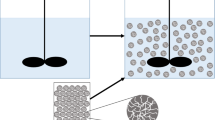Abstract
Adsorption-based air filters/cleaners are often used to remove gaseous contaminants to improve indoor air quality (IAQ) for residential and office buildings. The performance of a sorbent filter is affected by the sorbent filter design parameters (i.e., granular particle size, packing density), the environmental conditions (i.e., flow velocity, challenge gas concentration, temperature, and relative humidity), and the sorbent properties such as sorption isotherm and in-pellet diffusion coefficient. It is the combined effects of all these parameters that determine the performance of the filter. In this study, Convective Mass Transfer (C-MT) model and Convective and Diffusive Mass Transfer (C&D-MT) model were developed and numerically implemented to simulate the fundamental transport and sorption processes in sorbent-based filters. The models’ behaviors were investigated by simulating the effect of different parameters, and were validated by comparison with experimental data. Detailed mechanism analysis was conducted based on both modeled and experimental results, which indicates that the surface diffusion is a much more important mechanism than pore diffusion, and the external convective mass transfer process is a controlling factor compared to pellet diffusion. This model also provides a useful tool for designing, selecting or maintaining sorption-based filter/air cleaner for non-industrial building applications based on the predicted filter performance over its service life.
Similar content being viewed by others
References
Blondeau P, Tiffonnet AL, Allard F, Haghighat F (2008). Physically based modeling of the material and gaseous contaminant interactions in buildings: Models, experimental data and future developments. Advances in Building Energy Research, 2: 57–93.
Brosillon S, Manero MH, Foussard JN (2001). Mass transfer in VOC adsorption on zeolite: Experimental and theoretical breakthrough curves. Environmental Science and Technology, 35: 3571–3575.
Chen W, Zhang JS, Zhang Z (2005). Performance of air cleaners for removing multiple volatile organic compounds in indoor air. ASHRAE Transactions, 111(1): 1101–1114.
Cheng T, Jiang Y, Zhang Y, Liu S (2004). Prediction of breakthrough curves for adsorption on activated carbon fibers in a fixed bed. Carbon, 42: 3081–3085.
Do DD (1998). Adsorption Analysis: Equilibria and Kinetics. London: Imperial College Press
Do HD, Do DD, Prasetyo I (2001). Surface diffusion and adsorption of hydrocarbons in activated carbon. AIChE Journal, 47(11): 2515–2525.
Guo B, Chen W, Zhang JS, Smith J, Nair S (2006). VOC Removal performance of pellet/granular type sorbent media-Experimental results. ASHRAE Transactions, 112(2): 430–440.
LLNL (2007). SUNDIALS-SUite of Nonlinear and DIfferential/ALgebraic equation Solvers. http://www.llnl.gov/casc/sundials.
Mugge J, Bosch H, Reith T (2001). Measuring and modeling gas adsorption kinetics in single porous particles. Chemical Engineering Science, 56: 5351–5360.
Murakami S, Kato S, Ito K, Yamamoto A, Kondo Y, Fujimura J (2001). Distribution of chemical pollutants in a room based on CFD simulation coupled with emission/sorption analysis. ASHRAE Transaction, 107(1): 812–820.
Pei J, Zhang JS, Nair S, Chen W, Guo B, Wong J (2008). VOC removal performance of pellet/granular type sorbent media-From testing to predictions. ASHRAE Transactions, 114(2): 462–471.
Popescu RS, Blondeau P, Jouandon E, Colda I (2007). Breakthrough time of activated-carbon filters used in residential and office buildings-Modelling and comparison with experimental data. n: Proceedings of the REHVA World Congress CLIMA (2007), Helsinki, June, pp. 10–14.
Ranz WE, Marshall WR (1952). Evaporation from drops: Part II. Chemical Engineering Progress, 48: 173–180.
Reyes SC, Sinfelt JH, DeMartin GJ (2000). Diffusion in porous solids: The parallel contribution of gas and surface diffusion processes in pores extending from the mesoporous region into the microporous region. Journal of Physical Chemistry B, 104: 5750–5761.
Rosen JB (1954). General numerical solution for solid diffusion in solid beds. Industrial and Engineering Chemistry, 46(8): 1590–1594.
Ruthven DM (1984). Principles of Adsorption And Adsorption Process. New York: Wiley.
Seader JD, Henley EJ (1998). Separation Process Principles. New York: Wiley.
Sirca S, Hufton, JR (2000). Why does the linear driving force model for adsorption kinetics work? Adsorption, 6: 137–147.
Tien C (1994). Adsorption Calculations and Modeling. Boston: Butterworth-Heinemann.
Treybal RE (1981). Mass Transfer Operations. Boston: McGraw Hill.
Valiullin R, Kortunov P, Karger J, Timoshenko V (2005). Surface self-diffusion of organic molecules adsorbed in porous silicon. Journal of Physical Chemistry B, 109: 5746–5752.
Wakao N, Funazkri T (1978). Effect of fluid dispersion coefficients on particle-to-fluid mass transfer coefficients in packed beds. Chemical Engineering Science, 33: 1375–1384.
Yang RT (2003). Adsorbents: Fundamentals and Applications. New York: Wiley.
Author information
Authors and Affiliations
Corresponding author
Rights and permissions
About this article
Cite this article
Pei, J., Zhang, J. Modeling of sorbent-based gas filters: Development, verification and experimental validation. Build. Simul. 3, 75–86 (2010). https://doi.org/10.1007/s12273-010-0309-4
Received:
Revised:
Accepted:
Published:
Issue Date:
DOI: https://doi.org/10.1007/s12273-010-0309-4




